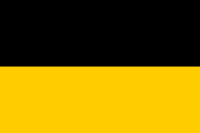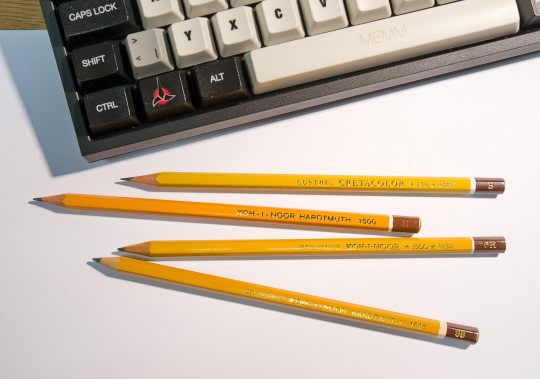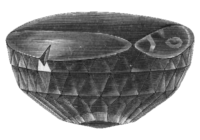Look who’s 125
It’s the Koh-I-Noor’s 125th birthday this year! Congratulations!
This pencil just featured in Contrapuntalism’s latest blog post (last picture) and I also mentioned it in my previous blog post.
The colour

If you are not familiar with the Koh-I-Noor: this is the pencil that might be the reason there are so many yellow pencils around, especially in North America. Petroski mentions a story in his book that describes how the L. & C. Hardtmuth Company picked yellow as the colour for this pencil because the flag of the Austro-Hungarian Empire (the same as the flag of the Habsburg Monarchy) was black and yellow [1]in the comments of this blog post Rick has corrected this: the flag of the Austro-Hungarian Empire was not black and yellow. However, both the flag of the Austrian Empire and the flag of the Kingdom … Continue reading – “and since the graphite was black, the pencil had to be painted golden yellow” [2]see Henry Petroski: The pencil (1989), p. 161 in my UK edition of this book.

The glory of the past
Now before I go any further I have to to say that the two descendants of the original Koh-I-Noor share the heritage but not the pompousness of the original Koh-I-Noor. I fear they also don’t share the high quality of the old Koh-I-Noor pencils which were given “fourteen coats of golden-yellow lacquer, the ends of the pencils were sprayed with gold paint, lettering was applied in 16-carat gold leaf” [3]see Henry Petroski: The pencil 1989, p. 191 in my UK edition of this book or the effort made to protect it – a Manx cat and her offspring were protecting the store rooms of this pencil from mice [4]again p. 191.

The name
Such a luxurious pencil needs a fitting name. The Koh-I-Noor pencil was named after the Koh-I-Noor diamond, a diamond from India that was once the largest known diamond. This diamond is set in the crown of Queen Elizabeth [5]see Wikipedia (That’s Queen Elizabeth, the wife of King George VI – not Queen Elizabeth II, the current queen). You can admire the Koh-I-Noor diamond in the Tower of London.
The Koh-I-Noor on both sides of the Iron Curtain
It all started to go a bit pear shaped for the Koh-I-Noor pencil when, after WWII, companies in Czechoslovakia were nationalised. At that time there was no pencil production in Austria as earlier production was moved to Budweis – when the Austro-Hungarian Empire was still around. On the other side of the Iron Curtain the descendants of Joseph Hardtmuth, the founder of the company, managed to re-establish pencil production of the Koh-I-Noor in Upper Austria in 1950 [6]see the Ruling of the Federal Court (of Switzerland) 83 II 312, p. 317 and were also able to use the Hardtmuth and Koh-I-Noor trademarks. Much later, in 1996 production of the Austrian Koh-I-Noor pencils would move East to Austria’s state of Burgenland, an area which, in 1950, was in Austria’s Soviet-occupied zone [7]I’d like to thank Cretacolor’s Mr. Ellmauthaler for this information.
The real successor
Which of these companies is the ‘real’ Koh-I-Noor L. & C. Hardtmuth? It’s difficult to say even or especially in my very simplified version of the story. You could argue that the company in Budweis is the real successor. Pencils were made in the same factory as before the nationalisation. On the other hand you could also argue that the Western branch is the real successor. All seven shareholders as well as most senior staff flew Czechoslovakia when the company was nationalised [8]see the Ruling of the Federal Court (of Switzerland) 83 II 312, p. 316 and moved the company with them.

For me both companies are successors of the original manufacturer. The company in Budweis does still exist. As mentioned earlier the Austrian branch moved to Burgenland. Their pencils are still being produced there. You can get Austrian made Koh-I-Noors, but there has been a change in ownership so the Koh-I-Noor pencils are now being sold under the name Cretacolor. You won’t find the successor, the Cretacolor 150, on Cretacolor’s web site, because of the web site’s focus on artists, but the 150 is selling well, not only in Austria, but also in countries like China [9]I’d like to thank Cretacolor’s Mr. Ellmauthaler for this information.
The image of the Koh-I-Noor originates from the Nordisk familjebok. The copyright for this image has expired.
References
| ↑1 | in the comments of this blog post Rick has corrected this: the flag of the Austro-Hungarian Empire was not black and yellow. However, both the flag of the Austrian Empire and the flag of the Kingdom of Hungary were black and yellow |
|---|---|
| ↑2 | see Henry Petroski: The pencil (1989), p. 161 in my UK edition of this book |
| ↑3 | see Henry Petroski: The pencil 1989, p. 191 in my UK edition of this book |
| ↑4 | again p. 191 |
| ↑5 | see Wikipedia |
| ↑6 | see the Ruling of the Federal Court (of Switzerland) 83 II 312, p. 317 |
| ↑7, ↑9 | I’d like to thank Cretacolor’s Mr. Ellmauthaler for this information |
| ↑8 | see the Ruling of the Federal Court (of Switzerland) 83 II 312, p. 316 |


